Centennial High Sophomores Experience Engineering/Entrepreneurship Courtesy of ME598 Grad Student Mentors
May 22, 2018
Dream of being on Shark Tank in a few years, lauding the merits of the unique product you designed and are marketing? Some budding young entrepreneurs from Centennial High School just might.
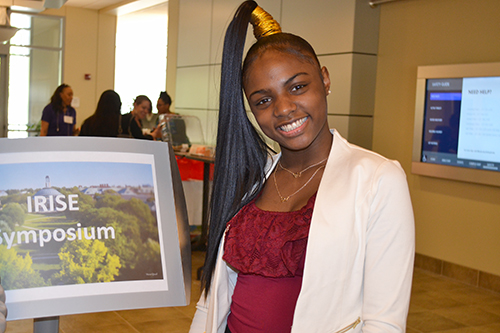
A Centennial High School student at the I-RISE Symposium.
For the second year in a row, these Centennial students in the AVID program had a chance to be mentored by Illinois Engineering grad students as part of the spring 2018 ME 598: Sustainable Engineering Outreach course. Facilitated by IRISE (the Illinois partnership for Respecting the Identities of Students in Engineering), the course was a win-win for both groups of participants. The six grad students had a chance to share their love of engineering and gain some skills regarding engineering outreach to underserved students. The Centennial 10th graders not only learned more about engineering and what it takes to be an entrepreneur, but networked with college students who could serve as mentors, not just now, but in the coming years. Plus, they gained some poster-making, presentation skills as they presented their posters at I-RISE’s May 7th Symposium, which included an awards ceremony and poster presentation.
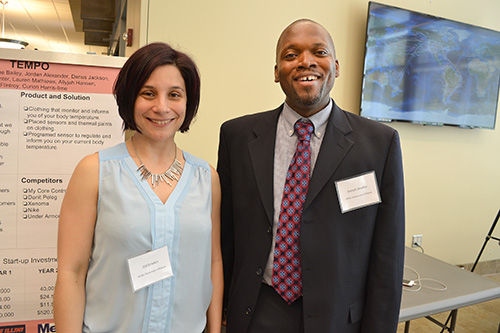
Elif Ertekin (left) with Joseph Bradley at the I-RISE Symposium.
The course was taught by Mechanical Science & Engineering (MechSE) Associate Professor Elif Ertekin; Education Outreach Coordinator, Joe Muskin; Uni High LIbrarian DoMonique Arnold; and joint Engineering and Business lecturer, Joe Bradley. Funded through Ertekin’s NSF Career grant, the course was revamped from a course taught several years ago by Arnold and Sharlene Denos, IRISE Associate Director and Associate Director for Education and Inclusivity in the Center for the Physics of Living Cells. The curriculum for the course was based on a curriculum that Denos and Arnold, who teaches a course on Race, Power, and Identity in Educational Psychology, developed for an interdisciplinary unit on race and racism at Uni High. Arnold helped design and coordinate the course curriculum, especially the social justice aspects of the class. Plus, Bradley, a newcomer who joined the team this year, “brought a lot in terms of the business and entrepreneurship perspective,” according to Ertekin.
According to Arnold, the curriculum changed quite a bit from last spring's, About half of the class time was dedicated to developing entrepreneurship, while the other half was. based on topics to help develop critically reflective mentorship and pedagogy for the grad students, during which they discussed "privilege and marginalization, how it might affect our work, and how to strategically intervene in situations where oppression is being perpetuated," Arnold explains. "In thinking about the forms of marginalization, we discussed social identity, with the emphasis on race, class, gender, and ability/disability.
To emphasize these topics, readings were assigned, and guest speakers were brought in. According to Arnold, the grad students acknowledged that the class "helped them think about and strategize about situations they were in academically, as well as making sense of personal situations.""
Arnold explains that the ultimate goal was to benefit the high school students, and that "by having this dialogue, and cultivating the framework that the grad students are using to think about outreach work, the grad students can more deeply connect with the high school students, and impart some of that framework to the high school students."
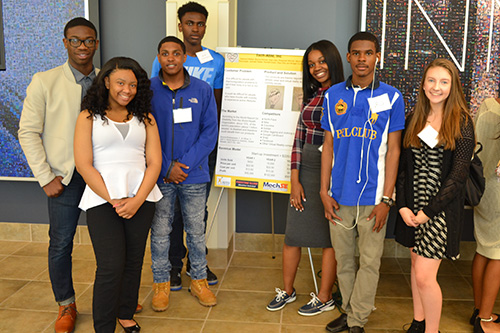
Centennial High School students from the Tech-Able team pose in front of their poster at the I-RISE Symposiium.
Ertekin explains that the two-year program design—which worked with the students first as freshmen, then again as sophomores—was intentional so the grad students would have a longer time period in which to interact with the students.
In terms of the engineering aspect, it built on the projects the highschoolers had developed last year: they were to use engineering to provide a solution to a problem in our local community—obstacles the Illini Wheelchair Basketball athletes encounter while training, competing, or just in everyday life. But Ertekin indicates that this year, the students—now sophomores—were not only able to expand on their engineering designs from the previous year but to “redesign their ideas with the idea of marketability and creating a business from that perspective.”
Do any of the young entrepreneurs plan to continue with their team’s project? Ertekin says possibly:
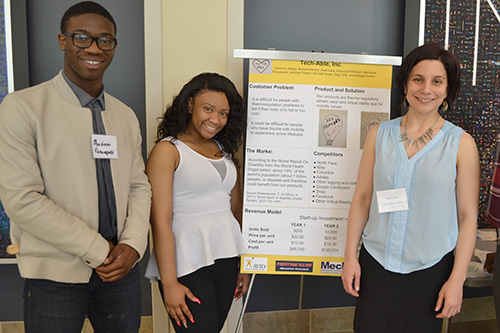
Associate Professor Elif Ertekin (right) with Centennial High students from the Tech-Able team, whose project was athletic wear with thermal regulation.
“We've heard from a lot of them that they are interested in seeing how they can push this forward. A lot have already been asking about how they can continue to be involved with us even after the conclusion of the program. So, yeah, I think they are interested in finding a way to keep building off of what they've done.”
According to Ertekin, one of the major benefits for the high schoolers, in addition to the exposure to engineering, was the networking that took place.
“That's one of the most important things that I think can come out of this–building your network around you, your resources, your community of people that are going to help you along the way.”
But it’s not just the high school students who benefit from working with the grad students. Both Ertekin and Arnold claim that the university folk have been reaping some benefits as well.
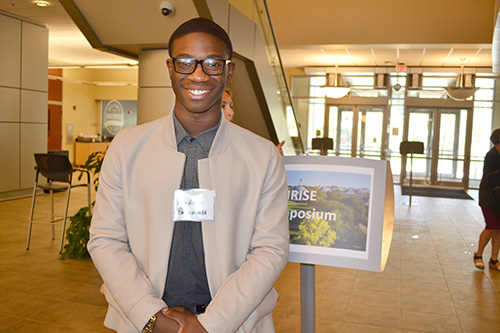
Mordoeai Panumpabi at the I-RISE Symposium.
“The nice thing is that goes both ways,” Ertekin continues. “We benefit from interacting with the students as much as they benefit from working with us. We learn things from each other, and we teach each other things, and that becomes a part of the larger community. The I-RISE program is really about setting up these long-lasting, long-term partnerships between STEM researchers here at the university and local schools and community organizations.
Arnold emphasizes that they repeated throughout the program that the relationship between the grad student mentors and high school students should be mutually beneficial. "We emphasized to the grad students how important it is to be open to what the high school students have to teach them; it is not a one-way street where they are only imparting knowledge to the high schoolers."
Joe Bradley adds that the program is also to remind the students that while it might be in their home town, Illinois is a world-class university, and that they’re welcome here:
“It's very important for them to see that we need them at the university and that their skills and talent that they bring are just as important. We wanted to make sure as a community that the university isn't just standing outside of being involved in the community, and we want to be a part of the learning experience for high school students and welcome them into the community. A lot of times we might draw students from other parts of Illinois, but are we really hitting the base in Champaign and other schools around here? So how to improve that presence so they know that even though they live in Champaign, we still want them as part of the university.”
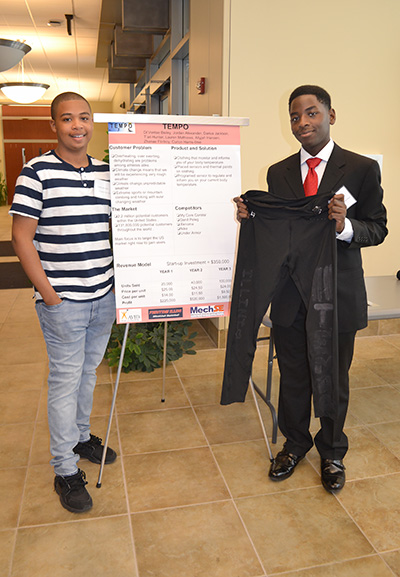
Darius Jackson (right) and one of his Tempo teammates show off their product, leggings that can sense that the athlete's body is overheating.
When it comes to Centennial High sophomore Darius Jackson, the University has hit a home run. No stranger to engineering research at Illinois, Jackson was also in the Physics Young Scholars program last summer (as a freshman) doing coding, physics, and engineering.
So despite the fact that no one in his family is an engineer, and most likely as a result of these interactions, Jackson has some ambitious career goals at this point. A particle physicist for one, or an engineer…or a video game developer. Possibly all three if he can squeeze them in!
“I want to be able to do all of my childhood dreams, so when I'm older I can be like, ‘I did everything. I feel accomplished.’ So probably a video game developer/designer, artist, all of that stuff, I'd like to be able to do. My main priority and what I'm trying to build towards is particle physicist and engineer, because that is a harder resume to build, so I'd like to start early.”
And Jackson is well on his way. He shares several things he learned from this experience. Collaboration for one: “Having eight minds working with each other,” he suggests, though he adds that it was a challenge: “It's something you really have to work with.”
Plus, he shares some other things he learned: “I learned how to code faster and easier, how to use everyday things with technology to make things better, and marketing. Marketing was a lot harder than I expected. I learned a lot of different things.”
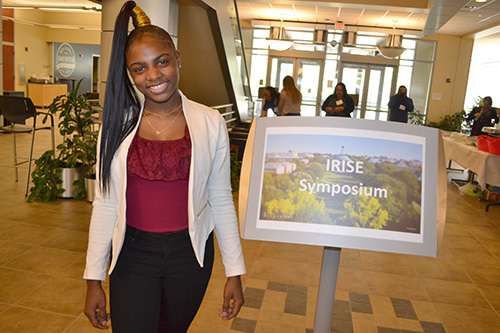
Jariyah Dillon at the I-RISE Symposium.
Sophomore, Jariyah Dillon was part of the Sensi team, which crreated a sensor system that attaches to a wheelchair to notify the user about the condition of its parts. She says she also learned a lot. While she confesses that she’s “not a big fan” of engineering, she admits, “I liked the coding part. I loved pretty much everything about it other than the worries. We worked so hard on this.” However, evidently one of the hardest things about the project was her tendency to worry about things.
“It was the worries,” she admits. “Just worrying about if we were going to do it right–—whether or not we were going to collaborate right. I was worried about and wondering if our presentation was going to be a mess. The project was pretty easy, but it was frustrating a few times because the sensing was off for the wheelchair conditions.”
Another sophomore, Toniea Barker, says the most rewarding thing about the project was encouraging each other on. “Being able to collaborate with everyone; being here at the U of I and seeing everybody present their ideas was an amazing experience because I've never encountered anything like this before, and it was lovely how there wasn't any hostility between anyone.”
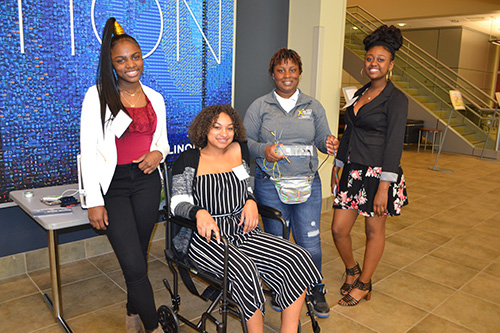
Jariyah Dillon (left), Toniea Barker (second from left) with some of the other Sensi teammates at the I-RISE Symposium.
The hardest thing, according to Barker was coming to a consensus regarding their project. “There were lots of ups and downs with this project, but picking the perfect project was the most difficult challenge. Each and every one of us put a piece of ourselves into this project.
Is engineering in her future? Maybe. “I actually do like engineering,” she says. “I didn't think I'd like it when we started this project two years ago, but it something that I will definitely look into.”
The high schoolers weren’t the only ones to benefit from the program. A couple of Illinois engineering students share why they got involved and what they got out of it.
For example, Aaron Anderson, a first-year, Electrical Engineering grad student, took the course because a couple of his friends had taken it and told him that it was good. One friend said it had been “invaluable for working with the high school students and gaining experience for himself.”
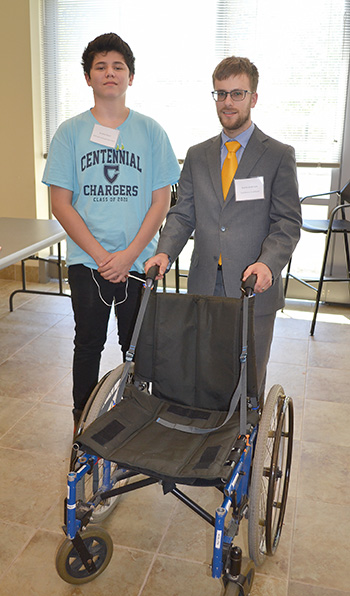
Aaron Anderson (right) with one of the Tilt Tech team members, along with the team's prototype wheelchair.
“I guess I care about all of the technical things that I'm learning as a graduate student,” Anderson acknowledges,” but I think it's important to apply what I'm learning to help people and the world become a better place. So taking this class is helping me understand how to do outreach and how to apply my technical knowledge to people that need it more broadly.”
Anderson, who worked with the Tilt Tech group, claims some of them could definitely have a future in engineering. “There were some really great ideas, and when we had a problem we wanted to solve, I suggested several potential approaches to solving the problem, and I think the students did a good job of thinking about the advantages about each. A couple of them, in particular, clearly understood and engaged with the suggestions to think about which would be best.”
The most challenging part of mentoring? Since he doesn’t have a lot of formal training or experience working with high-school-aged students, he found group management to be tricky. “If they're off task, how to help them get focused. That's not something that I'm experienced with and was challenging.”
He says that for the students, one of the challenges was recognizing and prioritizing the different things to work on. “It's not like math homework where there is a problem statement and the form of the answer is implied by the form of the question,” he suggests. “This project was not at all like that because we had an idea of what we wanted it to do, but there was no clear path, no example pattern they could follow. So figuring out how to work through the problem to the solution at the beginning.”
Fourth-year Mechanical Engineering grad student Brian Blankenau says the most rewarding thing out of this experience was “just showing up on Friday mornings and watching these guys do such a great jobs with their projects. Brian’s project was Tempo, which designed leggings/pants that would signal the wearer if they were overheating while exercising by changing colors.
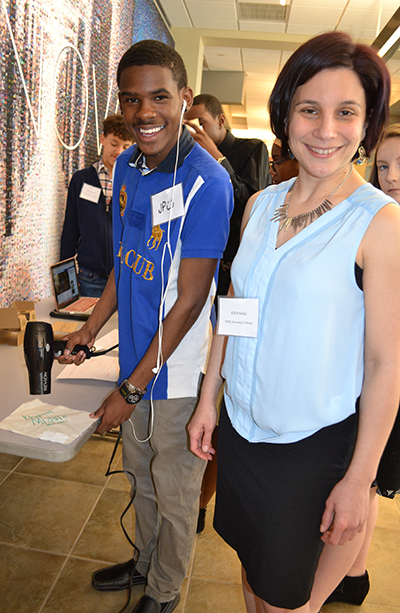
Elif Ertekin (right) and a member of the Sensi team who's demonstrating the thermal properties of their athletic wear.
While both he and his student team encountered challenges, he believes that getting university PhD students together with local high school students provided some benefits too.
For instance, Brian says that for the high school students, it was probably having a cheering section. “I know when I was in high school, it was, for me at least, hard to understand what really college was and whether or not I would be able to do well. And to be able to have someone there to say, 'Don't worry; you guys have this!' would have been nice.”
Brian agrees with fellow mentor Anderson that the PhD students got a couple of things out of the program too. For instance, they gained some teaching skills, and got to share their passion. “One of the things is, we don't have formal teaching training, so kind of getting some exposure to that is valuable, and then just getting the chance to be STEM ambassadors, I know a lot of my colleagues are looking for those opportunities.”
So the million-dollar question is, can some of these young entrepreneurs make a business out of their project? For example, can the Tempo team make a go of their sensor-modified leggings, or sell the idea to Nike?
Brian says possibly: “I think when they found their competitors, there were people that were doing things in a similar area, but I think they had a neat, unique project.”
Darius Jackson, for one, hopes to continue with Tempo’s project: “If I'm allotted the resources, then yes. I'd definitely try to market. Like you said, it's a different project, and there's nothing really out there like that. I think it could succeed if marketed well.”
Bradley also thinks it’s possible: “The possibility from a business perspective is they could potentially license the technology to Nike or have some sort of partnership with Nike for these types of clothing for the sun/thermal regulation, which with Nike's brand would be an ideal approach. But they could also find a niche market and still be very successful and just find the targets they specifically want to chase and spend their efforts there and still become a nice size company without getting the attention of larger companies like Nike.”
Story and photos by Elizabeth Innes, Communications Specialist, I-STEM Education Initiative.
For more I-STEM stories about IRISE, see:
- Engineering Grad Students Introduce High Schoolers to Engineering Via IRISE
- iRISE Course Prepares Engineers for Community Outreach
- iRISE and Denos Work to Get Students Hooked on Science in Middle School
- Physics Center Rises to the Challenge: iRISE Makes Learning Science Fun
More: Centennial, Graduate Education Reform, iRISE, Underserved Minorities, 2018
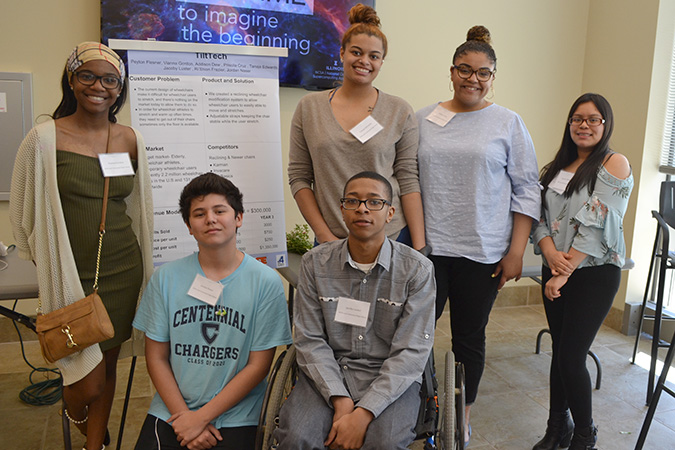
Centennial students on the Tilt-Tech team with their poster and prototype tilting wheelchair at the I-RISE Symposium.













.jpg)
















